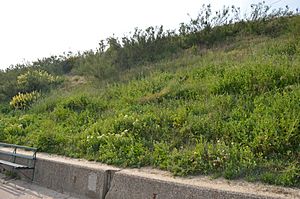Holland-on-Sea Cliff facts for kids
| Site of Special Scientific Interest | |
 |
|
| Area of Search | Essex |
|---|---|
| Interest | Geological |
| Area | 0.1 hectares |
| Notification | 1992 |
| Location map | Magic Map |
Holland-on-Sea Cliff is a very special place in Holland-on-Sea, near Clacton-on-Sea in Essex. It's a small area, only about the size of a football field (0.1 hectares). This spot is officially known as a Site of Special Scientific Interest (SSSI) because of its unique geology.
Being a SSSI means it's protected by law. This is because it helps scientists understand Earth's history. It's also a Geological Conservation Review site, which means it's one of the best places in the country to study certain geological features.
Contents
Why Holland-on-Sea Cliff is Special
This small cliff area is super important for understanding how the London Basin formed. The London Basin is like a giant bowl-shaped area of land where London and much of southeast England sits. Scientists study this site to learn how the land changed over thousands of years.
The Story in the Gravel
Holland-on-Sea Cliff is known as a "type site" for two special kinds of gravel. A type site is like the best example of something. These gravels tell us about ancient rivers and ice ages.
- Lower Holland Gravel: This gravel was left behind by the River Thames. It was the last layer of gravel the river dropped before something big happened. About 450,000 years ago, during a time called the Anglian glaciation, a huge ice sheet covered much of Britain. This ice sheet was so big it pushed the River Thames south, changing its path forever!
- Upper Thames Gravel: This gravel formed when the River Thames couldn't reach this area. The ice from the Anglian glaciation blocked the river's flow. So, this gravel tells us about a time when the river was stuck or flowing differently.
Clues from the Ice Age
These layers of gravel are like clues for scientists. Because they know these gravels are from the Anglian glaciation, they can use them as a "fixed point." This means they can compare these gravels to other rock layers found in southern Britain and even in other countries. It helps them piece together the puzzle of what happened during that ancient ice age.
Where is the Site?
The Holland-on-Sea Cliff site is a short part of the slope. You can find it between the Esplanade and the Promenade, across from Haven Avenue. It's interesting to know that even though it's a geological site, you can't easily see the actual rock layers or geology. The important parts are hidden beneath the surface.

